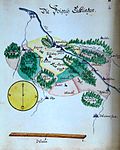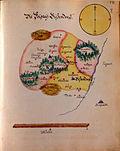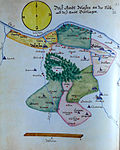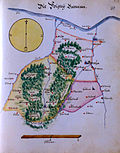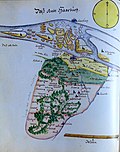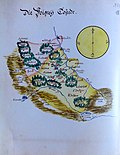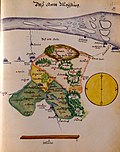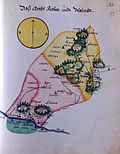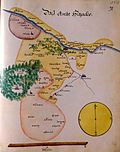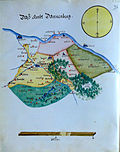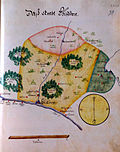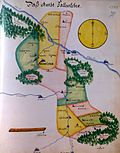List of offices and bailiffs in the Principality of Lüneburg
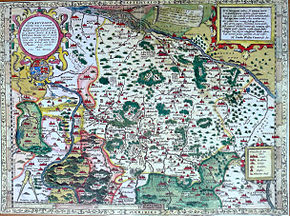
The list of offices and bailiffs in the Principality of Lüneburg describes the local administrative structures of the Principality of Lüneburg .
In the 13th and 14th centuries, goge dishes served the local administration of the country. Beginning in the 13th century, bailiwicks were established in the Principality of Lüneburg as local administrators. However, there is little knowledge about the development process. Since the 16th century the term office prevailed, the subdistricts of the offices were called bailiwicks . The main features of the office formation process were completed in the 16th century after the Reformation with the establishment of the monastery offices.
At the head of the offices was a bailiff appointed by the duke. The office included the so-called Amtshof , which was originally administered by the bailiff himself, but has mostly been leased since the 17th century. The offices of the ducal financial administration, the Rentkammer in Celle, were subordinated . The offices exercised the ducal power and were involved in the collection of sovereign taxes. In particular, they were the court of first instance for all civil disputes and minor criminal court cases. In addition, they were the administrative center for the ducal property, i. That is, they raised the manorial taxes due to the duke .
The constitution of offices remained in place even after the Principality of Lüneburg fell to the Electorate and later Kingdom of Hanover . In the 19th century there was an extensive reform of the office constitution, as a result of which the number of offices was initially sharply reduced and the aristocratic patrimonial courts were repealed. After the Prussian annexation of Hanover were from the remaining offices in 1885 finally counties formed as new administrative units.
List of offices and bailiffs
Explanation: The list of offices and bailiffs is based on the office atlas of Johannes Mellinger and describes the administrative division of the country around the year 1600. The closed aristocratic courts and the offices of the counties Hoya and Diepholz are not listed. The individual map sheets come from the 2001 reproduction of an atlas by Mellinger . This edition draws on the oldest of the five copies from the 17th century: the one stored in the Lower Saxony State Archives, Hanover Department , which is dated to around 1678. The map sheet from the Lüne Office and the Scharnebeck Office comes from the holdings of the Göttingen State and University Library because it is only a copy from the 20th century in the copy of the State Archives in Hanover.
| Name (location) |
map | History of the Bailiwick |
|---|---|---|
| Office of Celle | The Amt of Celle was known as the Vogtei Celle until the 16th century , then as the Amt Celle and finally as the Großvogtei Celle from the middle of the 17th century . It comprised parts of today's districts of Celle and Heidekreis as well as the Hanover region and served primarily to supply the Celler Hof . As the only one of the offices of the Principality of Lüneburg , it was never pledged. The Vogtei was headed by the Grand Bailiff , who was Vogt of Celle until the 16th century. In addition to his duties in local administration, he was also responsible for overseeing the court administration and was one of the most important members of the central administration of the Principality of Lüneburg . At the beginning of the 17th century, the office of Celle was divided into the twelve bailiffs of Celle, Eicklingen, Bedenbostel, Hermannsburg, Bergen, Winsen an der Aller, Esel, Soltau, Fallingbostel, Bissendorf, Burgwedel and Ilten. | |
| Burgvogtei Celle ( ) |
The Burgvogtei Celle formed a narrower district around the Celle Castle . Until the 17th century it was sometimes referred to as the Vogtei Schlösserey , as the Vogtei was under the control of the so-called Sluter, the castle bailiff of Celle. According to the Celle treasure register of 1438, the Bailiwick comprised the parishes of Altencelle and Hehlen at that time and was therefore essentially as extensive as it was in the 18th century. The city of Celle itself, as an office -based city, was not subject to the Vogt. Originally there was a Gogericht in the Bailiwick, but its judicial rights had already passed to the Bailiwick of Celle in the 14th century. | |
| Bailiwick of Eicklingen ( ) |
The Bailiwick of Eicklingen comprised the parishes of Wienhausen , Langlingen , Müden, Bröckel and parts of the parishes of Nienhagen and Päse in 1438 . At that time it had the same size as is documented for the 18th century. The Bailiwick originally formed a Go, but its judicial rights had already passed to the Bailiwick of Celle in the 15th century. A gogreve , which is still documented for 1461, was at that time only a subordinate official of the Celle bailiff. The Bailiwick has been known as the Eicklingen District Bailiwick since the 17th century . | |
| Bailiwick of Bedenbostel ( ) |
The Bailiwick of Bedenbostel was referred to as Bailiwick on the Grethe until the 15th century , then as Bailiwick of Bedenbostel and finally in the 18th century as the District Bailiff of Bedenbostel . In 1438, 21 localities in the parishes of Bedenbostel and Esche belonged to the bailiwick, and in the 18th century the bailiwick comprised 32 villages in the parishes of Bedenbostel, Höhne, Eldingen and Esche. At this time the bailiwick was divided into the (lower) bailiwicks Höhne and Esche. In the area of the Bailiwick there was originally a Go, to which a district court goes back, which was held in Bedenbostel in the 17th century. | |
| Bailiwick of Hermannsburg ( ) |
The Bailiwick of Hermannsburg comprised the parish of Hermannsburg in 1438 and thus already had the extent that is documented for the 18th century. The parish of Hermannsburg originally corresponded to a Go, which is still documented by a Gogreven in 1466 , but whose judicial rights had already passed to the Bailiwick in Celle at that time . A regional court, which was held by the Celler Vogt in Hermannsburg, also goes back to this judicial district. Since the 17th century, the bailiwick has been known as the Hermannsburg District Bailiwick . | |
| Bailiwick of Bergen ( ) |
The Bailiwick of Bergen was made up of the parishes of Bergen , Wietzendorf and Sülze (belonging to the parish of Bergen until 1502). The exact scope is not yet apparent from the registers of the 16th century; more detailed written evidence was only available in 1666. Since Bergen and Witzendorf still appear as independent income districts in the registers of the Celle bailiffs in the 14th and 15th centuries, it can be assumed that the bailiwick was only combined into an administrative unit in the 16th century. Together, Bergen and Witzendorf had already formed a Gogericht , headed by the Celler Vogt. | |
| Bailiwick of Winsen an der Aller ( ) |
The Bailiwick of Winsen an der Aller comprised the parish of the same name with 22 villages. The name Vogtei Winsen is first recorded in the 16th century, and since the 17th century the Vogtei has been known as the Amtsvogtei Winsen . The parish of Winsen was a former Go, for 1378 a court hearing under the direction of the Celler Vogte is documented. | |
| Bailiwick of Essel ( ) |
The bailiwick of Essel , from the 17th century as the district bailiff of Essel , comprised the parish of Schwarmstedt with 9 associated villages. The extent already corresponded to that of the 17th century in the 15th century, at that time the Vogtei was still listed in the register as the parish of Schwarmstedt. The parish was a former Go, to which a district court went back, which was headed by the Celler Vogt. | |
| Bailiwick of Soltau ( ) |
The Bailiwick of Soltau comprised the parish of Soltau with the city of Soltau and 16 other localities. The parish of Soltau corresponded to an old Go, which is still mentioned in the registers in 1378. In the 15th century there was still a villication in Soltau that was owned by the Verden Monastery and sold to the Duke of Lüneburg in 1479. | |
| Fallingbostel Bailiwick ( ) |
The Bailiwick Fallingbostel included in the 15th century, the parishes Fallingbostel , Meinerdingen , Düshorn and Dorfmark and had thus already essentially the amount that is still occupied in the 18th century. At the same time, however, the parishes are still listed as independent revenue districts in the treasury registers of the 14th and 15th centuries. In the 15th century the district was called Heidmark , the name Vogtei Fallingbostel appears for the first time in the 16th century. Since the middle of the 17th century it was called the Amtsvogtei Fallingbostel . The Vogtei corresponded to an old Go, to which a regional court goes back, which was held by the Celler Vogt until the 18th century. | |
| Bissendorf Bailiwick ( ) |
The Bissendorf Bailiwick was known as Wedemark until the 15th century , then as Bissendorf Bailiwick , and finally as Bissendorf District Bailiff from the middle of the 17th century . In the 15th century it comprised localities and farmsteads in the parishes of Brelingen , Bissendorf , Mellendorf , Engelbostel and Helstorf and thus essentially had the same scope as is documented for the 18th century. The Wedemark originally formed a go, whose court was held in the 15th century by the Celler Vogt in Mellendorf. | |
| Burgwedel Bailiwick ( ) |
The Vogtei Burgwedel emerged as a unified administrative district in the 16th century and since then has comprised the parishes of Isernhagen , Burgwedel and Wetmar. The areas were previously referred to as Grafschaft Burgwedel , which were under the Vogt of Neustadt until the 15th century. However, precise information about the county is not available. In the Vogtei there was a free court, which was held several times a year by the Burgwedeler Vogt until 1672, and a Hagengericht, which was held by the Celler Vogt until the 18th century. However, there is no evidence of an older Gobezirk in the Bailiwick. | |
| Bailiwick of Ilten ( ) |
In the 18th century, 14 villages belonged to the Ilten Bailiwick , which were also known as " The Great Free " and originally formed their own Go. The residents did not belong to any landlord and owned their farms. The ownership of the area changed several times up to the 16th century, it was not until 1512 that it finally belonged to the Principality of Lüneburg. |
| Name (location) |
image | History of the Bailiwick |
|---|---|---|
|
Office Winsen ad Luhe ( ) |
The Winsen an der Luhe office , also known as the Winsen Grand Bailiff since the 15th century , formed an administrative center in the northern part of the Principality of Lüneburg. The seat of the office was the castle or palace in Winsen . After the destruction of the castle on the limestone in 1371, the management of the Lüneburg United bailiwick, which until now the administrative center for the displaced here towards billungisch - Guelph had been goods in the northern part of the duchy. Several bailiffs were subordinate to the office in Winsen, the scope of the office and the exact relationships of dependency changed several times in the course of history and are only partially evident from the sources. In his official atlas, Mellinger assigns the city of Winsen, the bailiwicks of Marsch and Neuland, the Go Salzhausen (later Bailiwick Garlsdorf) and the Bardowick bailiwick directly to it. Pattensen , Amelinghausen and Bienenbüttel are shown on their own maps, but their dependency on the office in Winsen becomes clear through their designation as bailiwicks. In the 18th century, the Winsen office finally included the city of Winsen, the bailiwicks of Marsch and Neuland and the bailiffs of Pattensen, Amelinghausen, Bardowick, Garlsdorf and Bienenbüttel. In contrast to the Großvogtei Celle, Winsen was repeatedly pledged until the 16th century, and it was not until 1523 that Winsen was permanently under sovereign administration. | |
| Bailiwick of Amelinghausen ( ) |
The Bailiwick of Amelinghausen comprised 39 villages in 1450. Some of these places were located on the territories of adjacent offices, disputes between the offices over responsibilities in sovereign issues dragged on until 1664. The bailiwick goes back to a former Go, whose court was held as a district court by the Winsen captain in the 16th century. At this point in time, the dukes of Celle had already combined most of the manorial rights and judicial rights in the bailiwick in their hands. Only the logging courts of the Amelinghausen and Raven parishes remained in the possession of aristocratic families until the 19th century, as did the wooden court over the Druwald, which was owned by the Bishop of Verden . The Bailiwick, or since the 17th century the District Bailiwick, Amelinghausen was subordinate to the office in Winsen. | |
| Bailiwick Pattensen ( ) |
The bailiwick of Pattensen goes back to a former court district and corresponded to the parish of Pattensen . The Gogericht was held as a regional court together with the logging court by the Winsen captain or, in later years, by a regional court commissioner at the administrative court in Pattensen. The extent of the Bailiwick is first clear in the Landschatzregister from 1450, at that time the Bailiwick comprised 13 villages. In the 17th century, Pattensen, now as the district bailiff, was united with the Eight Ramelsloh . Ramelsloh probably also goes back to a Gogerichts district and a Holzmark (eight). In 1450 it was listed in the state treasury register as an independent revenue district and at that time comprised 22 localities. The bailiwick, or since the 17th century the district bailiff, Pattensen was subordinate to the office in Winsen. | |
| Bienenbüttel Bailiwick ( ) |
The Bailiwick Bienenbuttel included in 1450 treasure requiring farms in 52 villages, 1795, she had subjects in 61 places. The compulsory courts of the bailiwick were spread over the sovereign territories of the offices of Lüne, Scharnebeck, Bleckede, Garze, Medingen, Ebstorf, Bodenteich and Winsen, the place Bienenbüttel itself was in the office of Medingen. It is assumed that the compulsory farms among the Billungers had formed a closed complex and that this was dissolved through inheritance and donations to the monasteries of Kemenade, Medingen, Lüne, St. Michaelis and Scharnebeck. The Bailiwick, or since the 17th century the district bailiff, Bienenbüttel was subordinate to the office in Winsen. In 1795 the bailiwick was dissolved. | |
|
Harburg Office ( ) |
The Office Harburg divided since the mid-17th century in the six marching bailiwicks Finkenwerder, Altenwerder , Lauenstein break , Kirchwerder , over and territory as well as the four Geest bailiwicks Höpen, Hittffeld, Jesteburg and Tostedt. In total, the office comprised seven Elbe islands, a city, 90 villages and 12 independent farms. Harburg originally belonged to the County of Stade until Duke Otto was enfeoffed with the area for the first time in 1236. Until the 16th century, Harburg was mostly pledged, including to the cities of Hamburg , Lüneburg and Hanover . In 1527 Duke Otto received the rule of Harburg as compensation for his government waiver. Since then, Harburg, supplemented by the Moiseburg office in 1560 , formed its own domain, which, however, did not achieve complete sovereignty. After the Harburg line of the Welfs died out in 1642, the office fell back to the Celle line and has been under sovereign administration ever since. | |
| Bailiwick of Tostede ( ) |
The Bailiwick of Tostedte comprised 14 villages at the beginning of the 17th century. In the 18th century it had lost its independence and was only a subordinate of the Harburg office. At that time it consisted of 19 localities of the parish Tostedt , six localities of the parish Hollenstedt and one village of the parish Undeloh . Presumably Tostedt corresponded to a former Go. A district court was held until the 17th century. | |
|
Office Moisburg ( ) |
In the 18th century the Moisburg office was divided into the Moisburg bailiwicks with 6 localities, the Hollenstedt bailiwick with 26 localities and the Elstorf bailiwick with 15 localities. The scope of the office goes back essentially to the 16th century, in the 15th century only 17 villages are occupied for Vogedie Moisedeborg . Moisburg originally belonged to the County of Stade until Duke Otto was enfeoffed with the area for the first time in 1236. Until 1560, the office had mostly been pledged, among others to the city of Lüneburg and the families of Oppershausen and von der Wense . In 1560 the office came to the rule of Harburg, after the Harburg line of the Welfs died out in 1642 it came back to the Celle line and has been under sovereign administration ever since. | |
|
Meinersen Office ( ) |
The Meinersen office goes back to the Bailiwick of Meinersen Castle . This was owned by the noble von Meinersen family until the 14th century and was originally an imperial fiefdom. In the 14th century, however, the Guelph dukes appeared as feudal lords, and the family had already lost their independence by then. From 1428 to 1512 it belonged to the Principality of Wolfenbüttel until it fell back to Lüneburg through the Treaty of Minden. In the 16th century it was pledged to the von Saldern family until it was redeemed in 1532 and has been under sovereign administration ever since. In the 18th century it was divided into the house bailiwick, the bailiwick of Ütze and the Gogräfschaft Edemissen . The latter originally formed its own judicial district, but this cannot be proven for the house bailiwick and for Ütze. It is assumed that the office had the scope of the 18th century as early as 1512 when Lüneburg fell. | |
|
Burgdorf Office ( ) |
The Office Burgdorf included in the 18th century, the parishes Obbershagen , Burgdorf, Steinwedel and Horst with a total of one city and 20 villages. The parishes of Burgdorf, Steinwedel and Horst formed a Go, the judicial system of which was preserved until the 16th century. Burgdorf was ceded to the Celle dukes in 1422 after a feud with the Hildesheim bishop . Until the 17th century it was mostly pledged, including to members of the principality's central administration. It was not until 1659 that the office was under sovereign administration. | |
|
Office Ahlden ( ) |
The Ahlden office was founded on a former Go and Villication and has belonged to the Principality of Lüneburg since the 15th century. It comprised the parishes of Ahlden with the areas of Ahlden and Hudemühlen, 10 villages and two independent farms and the parish of Eickeloh with two villages. Until the 16th century, Ahlden Castle and the Bailiwick were mostly pledged, including to the von Mandelsloh family. Sophie Dorothea was exiled to Ahlden from 1694 to 1726 and was given the office as a personal asset . In the 16th century, Ahlden was under the supervision of the Grand Voyage of Celle, in the 17th century and then again from 1726 to 1784 it was under the supervision of a noble Landdrosten, together with the Rethem and Walsrode offices. | |
|
Office of Rethem ( ) |
Center of the Office Rethem was the castle Rethem . This had been in sovereign possession since the first half of the 14th century, but in the 15th, 16th and 17th centuries it was mostly in the possession of the city of Lüneburg as a lien . The office was only permanently under sovereign administration from the middle of the 17th century. In the 18th century the office was divided into the house bailiwick, the Gogräfschaft Boitzen, the Gogräfschaft Cordingen and the aristocratic court in Wahlingen. The house bailiwick, which is only mentioned under this name in the 18th century, comprised three villages and three farms in addition to the town of Rethem. The Gogräfschaft Boitzen was an old Gogericht that in addition to the parish Boitzen also included the Holzmark Boitzen. Its court was held as a regional court until the 16th century under the direction of the Rethemer bailiff. The Gogräfschaft Cording corresponded to the parish of Walsrode and also goes back to a Gogericht. The aristocratic court of Wahlingen comprised nine villages in the parishes of Rethem and Kirchwahlingen and eleven vacant Burgmann seats. In it a court had been preserved, which had the lower and higher jurisdiction and whose chairman was elected by the local Burgmann families. In 1852 the court was overturned. From the middle of the 17th century until 1784, Rethem, together with the offices of Ahlden and Walsrode, was under the supervision of a noble Landdrosten. | |
|
Walsrode Office ( ) |
The Walsrode office was established in 1528 in the course of the Reformation through the secularization of the priests of the Benedictine monastery of Walsrode . It was the smallest of the Lüneburg offices and, as a judicial district, only comprised the monastery buildings, the Vorwerk with the prop part estates, the office building, two parsonages, the widows' houses and two other houses, provided that their residents were not subject to the jurisdiction of the city of Walsrode . It exercised manorial rights over 60 farms, which were, however, on the territory of the surrounding offices and bailiwicks. | |
|
Office Bütlingen ( ) |
In the 18th century, the Bütlingen office consisted of the villages of Bütlingen , Lüdershausen , Barum and Brietlingen . In 1450, Bütlingen and Lüderhausen are still part of the Bardowick Bailiwick, and only then did they become independent. After Lüderhausen was still an independent bailiwick in the 16th century, it finally became part of the Bütlingen office in the 17th century. In 1794 the Bütlingen office was merged with the Scharnebeck office. | |
|
Office Lüne ( ) |
The Lüne office was established in 1529 as part of the Reformation to manage the secularized provost property of the Lüne monastery . Together with Scharnebeck it formed the Go Modesstorp, whose court was still held in the 18th century. At that time it was divided into the house bailiwick and the bailiwick of Barendorf. The house bailiwick comprised 30 villages, some of which were on the territory of the Winsen an der Luhe office . The Barendorf Bailiwick comprised 21 villages, some of which were in the offices of Medingen, Scharnebeck and Bleckede . In 1794/1795 the Lüne office was given judicial and sovereign powers over a total of 53 subjects who lived on the territory of the office but previously belonged to other offices. | |
|
Office Scharnebeck ( ) |
The office of Scharnebeck was created in the course of the Reformation to manage the secularized provost property of the Scharnebeck monastery. Together with Lüne it formed the former Go Modesstorp, whose court was still held in the 18th century. In the 18th century it included the parishes of Scharnebeck and Echem as well as subjects in nine villages of the Lüne office, six of the Bleckede office, three of the Lauenburg office and five of the Winsen an der Luhe office. In 1794 the office of Scharnebeck was combined with the office of Bütlingen. | |
|
Office Ebstorf ( ) |
The Ebstorf office was established in 1528 in the course of the Reformation through the secularization of the provost property of the Benedictine convent Ebstorf and consisted of the former Goen Ebstorf and Münster. The Go Ebstorff is mentioned for the first time in a document from 1380 under the name "ghoo to Ebbekestorpe" and already belonged to the monastery at that time, the Go Munster acquired the monastery in 1450 at the latest. The Gogerichte were still in the 18th century as regional courts. Century held regularly in Ebstorf and Munster. In the 18th century the office was divided into Veesten Hanstedt, Wriedel, Munster, Oerrel, Schwienau, Kleyveest and Schwienauer Veest, and at that time comprised 48 villages, 7 farms and one spot. Two of these localities belonging to the Ebstorf Office were on the territory of the Bodenteich Office. The division according to Veesten is already evident from the documents of the 15th century and lasted until the 19th century. In 1852 the office was finally reorganized. | |
|
Office Medingen ( ) |
The Medingen office was created in 1529 through the secularization of the provost property of the Cistercian monastery in Medingen . In 1665 it comprised 57 villages and was divided into the Bevenser Vogtei, the Hausvogtei, the Barumer Veest, the Riester Veest, the Addenstorfer Veest, the Niendorfer Veest, the Oldenmedinger Veest, the Strohter Veest and the Große Hesebecker Veest. This scope remained essentially until 1794/1795, when Medingen was given responsibility for other localities from the offices of Bienenbüttel and Bodenteich. The scope of the office went back to the Go Bevensen, whose Gogericht was held until the 17th century. The Goger jurisdiction was originally owned by the Bishop of Verden, who then sold it in 1450 to the St. Michaelis monastery, which in 1481 sold it to the monastery in Medingen. | |
|
Bleckede Office ( ) |
In the 18th century, the Bleckede office was divided into the Hausvogtei, the Marschvogtei, the Vogtei Barskamp and the Dahlenburger Vogtei. In essence, the office still had the same scope in the 18th century that was also documented in the 16th century. The office goes back to the bailiwick of Bleckede Castle, which the Celle dukes acquired in 1308. Until the 16th century, the office was in lien property of the city of Lüneburg, and it was not until 1561 that the office was under sovereign administration. | |
|
Office Bodenteich ( ) |
In the 18th century, the Bodenteich office was divided into the Hausvogtei, the Vogtei Suderburg, the Vogtei Jarlitz, the Veest Stadensen, the Veest Halligdorf, the Veest Moltzen, the Veest Könau and the Veest Spiethal. In addition, the Oldenstadt office and the office-based city of Uelzen were located on its territory . The office had been pledged several times until the 17th century, and it was not until 1654 that it was permanently under sovereign administration. | |
|
Office Hitzacker ( ) |
The Hitzacker office goes back to the Bailiwick of Hitzacker Castle . The castle is already mentioned in the certificate of division of the children of Henry the Lion from 1203. The ownership structure was still controversial in the following centuries, it was not until the 14th century that it finally fell to the Celle line of the Guelphs. The castle and the bailiwick had since been pledged repeatedly by the dukes. In the 14th century they were in the possession of the city of Lüneburg, in the 15th and 16th centuries in the possession of the von Bülow family . In 1591 Heinrich the Younger was awarded the bailiwick as part of the Dannenberg rule , which, however, did not achieve complete sovereignty. After the Dannenberger line died out in 1671, the bailiwick fell back to the main line of Celle. The Vogtei Hitzacker is mentioned for the first time as a unified administrative district in the treasury register of 1450 and at that time comprised 41 localities. In 1717, Hitzacker, now known as the Hitzacker Office , consisted of 51 villages. These were divided into the Überelbischen villages (9 localities), the Marschdörfer (4 localities) and the Geestdörfer (38 localities). For the organization of the sovereign services, the office was divided into cloths, each of which included three to seven places. The exact composition and names of the cloths changed again and again. Within the sovereign boundaries of the Bailiwick, there were still twelve villages of the Dannenberg office and one village of the Wustrow office in the 18th century. In 1859, Hitzacker was merged with the Dannenberg office. | |
|
Lüchow Office ( ) |
The Lüchow office goes back to the County of Lüchow . This originally included the castle and city of Lüchow and the castles Gartow , Bodenteich, Wustrow and Klötze . First mentioned in a document in 1144, Duke Otto acquired the county in 1320. The Lüchow Bailiwick is mentioned for the first time in a pledge in 1371, but the extent of the Bailiwick at that time is not evident from the document. Until the 16th century, Lüchow was mostly mortgaged. In 1548 the office was combined with the Warpke office. Up until this union, Warpke had mostly been pledged, including to the von Bodenteich, von der Schulenburg and von Meding families . In 1591, Duke Heinrich received the Lüchow office as compensation for his renunciation of participation in the government. Lüchow thus became part of the Dannenberg rule , which, however, did not achieve complete sovereignty and fell back to the Celler line after the Dannenberg line of the Welfs died out. In 1695 there was a land consolidation, as a result of which properties scattered between the offices of Lüchow, Dannenberg and the closed Gartow court were exchanged. | |
|
Office Dannenberg ( ) |
The office of Dannenberg goes back to the County of Dannenberg , which was first mentioned in a document in 1162 and was acquired by Duke Otto II in 1303. According to a treasury register in 1450, the Bailiwick comprised more than 50 villages, 45 of which belonged to the Dannenberg district in the 18th century. At that time it was divided into the Marschvogtei with 32 localities and the Hausvogtei with one city, 40 localities and three independent courtyards. This subdivision was not based on old parish or geographic boundaries, but was based on topographical boundaries. For the sovereign services, the office was divided into cloths, with several villages belonging to one cloth. Until the 16th century, the office was mostly pledged, pledge takers were among others the city of Lüneburg and the von Bülow family. In 1569, the office of Dannenberg fell to Duke Heinrich zu Braunschweig and Lüneburg as compensation for his government waiver and, together with the office of Schnackenburg, formed the dominion of Dannenberg. He had Dannenberg Castle built as a residence. In 1671 Dannenberg came back to the Celle line of the Guelphs and has been under sovereign administration ever since. In 1859 it was merged with the Hitzacker Office and in 1885 it became part of the Dannenberg district. | |
|
Office Knesebeck ( ) |
The Office Knesebeck included in the 18th century a patch, 25 towns, six separate courtyards and aristocratic courts in Brome and Fahrenhorst. The same extent is essentially documented as early as the 16th century. The office goes back to the bailiwick of Knesebeck Castle , which was owned by the von Knesebeck family until the 14th century , until it was purchased by the dukes Otto and Wilhelm in 1343. In the following centuries the office was mostly pledged, most recently from 1672 to 1754 to the Grote family . The noble court of Brome belonged to the von der Schuleburg family, who exercised both lower and upper jurisdiction. Whether it was a so-called closed aristocratic court, i.e. whether the von der Schulenburg family also exercised sovereignty in addition to the rule of law, is controversial in the literature. The owner of the aristocratic court in Fahrenhorst was entitled to lower and higher jurisdiction, while the authority of Knesebeck exercised the sovereign rights. | |
|
Office Isenhagen ( ) |
The Isenhagen office was created in 1533 through the secularization of the provost property of the Isenhagen Cistercian monastery in the course of the Reformation. The closed territory in which the office exercised internal jurisdiction only included the monastery land with the preacher's and sexton's apartment, the office building, the Vorwerk, the brewery, the mill and the village of Alt-Isenhagen. In addition, the office exercised the manorial rule over house locations in the offices of Gifhorn, Bodenteich, Knesebeck, Medingen, Lüchow and Bleckede. In 1799 the area of the office was significantly enlarged when it was given responsibility for the Gogräfschaft Hankensbüttel and the bailiwick of Steinhorst from the Gifhorn office. | |
| Gogravschaft Hankensbüttel ( ) |
The Gogräfschaft Hankensbüttel belonged to the Gifhorn office in the 18th century and at that time included localities in the parishes of Hankensbüttel , Sprakensehl and Isenhagen . In the 16th century the Gogräfschaft was still an independent judicial district in which the captain von Gifhorn held a court three times a year. | |
| Bailiwick of Steinhorst ( ) |
The Bailiwick of Steinhorst and the Gogräfschaft Hankensbüttel and the Bailiwick of Wahrenholz formed an older judicial district with the name "Heidmark", which was mentioned in the documents as a revenue district in the 16th century. In the 18th century, the Bailiwick was initially part of the Gifhorn District Bailiwick and at that time comprised four localities in the Steinhorst parish, four localities in the Ösingen parish and one town in the Eldingen parish belonging to the Bedenbostel parish . In 1799 the bailiwick fell to the Isenhagen office. | |
|
Office Gifhorn ( ) |
In the 16th century, the Gifhorn office consisted of the official city of Gifhorn and 14 localities in the parish of the same name. The center of the office was the castle in Gifhorn , which was one of the most important fortresses on the southern border of the principality. In the 13th and 14th centuries, Gifhorn changed hands several times, and it was not until 1428 that it finally belonged to the Principality of Lüneburg. Until 1520 Gifhorn was mostly pledged, among others to the city of Lüneburg and the Lords of Bokmast. In 1539, Duke Franz received Schloss und Amt Gifhorn as compensation for his government waiver. The so-called Duchy of Gifhorn , however, remained part of the sovereign territory of the principality and fell back to the main line in Celle after Franz's death in 1549. In the 18th century, in addition to the areas of the parish of Gifhorn, now referred to as the house bailiwick, it included the Bailiwick Wahrenholz, the Bailiwick Steinhorst, the Gogräfschaft Hankensbüttel and the so-called Papenteich , the old Gogräfschaft Rötgesbüttel. In 1799 the office ceded the responsibilities for the Gogräfschaft Hankensbüttel and the Vogtei Steinhorst to the office Isenhagen. | |
| Papenteich in the Gifhorn office ( ) |
The Papenteich in the Gifhorn office goes back to the Gogräfschaft Rötgesbüttel . This was still an independent judicial district in the 16th century, in which Captain von Gifhorn held a court three times a year. In the 18th century, the Papenteich was part of the Gifhorn office and at that time comprised 41 villages and 7 independent courtyards. | |
|
Fallersleben Office ( ) |
Fallersleben Castle was the center of the Fallersleben office . This changed hands several times in the 13th and 14th centuries, and it was only in 1428 that it finally belonged to the Principality of Lüneburg. In the 15th century it was pledged to the von Bülow and von Alvensleben families, and in the 17th century it was again in the possession of the von der Wense family until it was redeemed in 1641 and has been under sovereign administration ever since. In the 18th century it was divided into the Gogräfschaft Grevenla and the Gogräfschaft Hasenwinkel, each of which was headed by a gographer. The Gogräfschaft Grevenla included the spots Fallersleben and Höfe in the parishes Fallersleben, Hattorf, Sülfeld and Wolfsburg . The Gogräfschaft Hasenwinkel comprised the parish Heiligendorf and localities of the parishes Neiendorf, Rode and Ochsendorf . | |
|
Office camping ( ) |
The Campen office with Campen Castle as the official seat came to the Principality of Lüneburg through the Treaty of Minden in 1512. In 1706 it was ceded to the Principality of Braunschweig-Wolfenbüttel . | |
|
Office blocks ( ) |
The office of Klötze formed an exclave and was surrounded by the Altmark Brandenburg . The official seat was the castle Klötze . The office consisted of several, non-contiguous areas and included the localities of Klötze , Kakerbeke, Lockstedt , Trippigleben, Breitenfelde , Römnitz , Kusei, the manorial Vorwerk Dölnitz, the forester's Gansau and the Krug Kickernitz. Klötze had belonged to the Principality of Lüneburg since the 14th century after the dukes Bernhard and Heinrich had conquered the castle militarily. Klötze was mostly pledged, among others to the families von der Schulenburg, von Alvensleben and Grote. It was redeemed by the latter in 1743 and has been under sovereign administration ever since. In 1810 the office of Klötze was ceded to Prussia . |
literature
- Peter Aufgebauer , Kirstin Casemir, Ursula Geller, Dieter Neitzert , Uwe Ohainski, Gerhard Streich (Eds.): Johannes Mellinger: Atlas des Fürstentums Lüneburg around 1600 (= publications of the Institute for Historical Research, Vol. 41), Publishing House for Regional History, Bielefeld 2001, ISBN 3-89534-391-9 .
- Martin Krieg: The origin and development of the administrative districts in the former principality of Lüneburg , Wenner, Osnabrück 1975 (reprint of the Göttingen edition 1922), ISBN 3-87898-089-2 .
- Ernst Schubert : History of Lower Saxony. Volume 2. Part 1. Politics, constitution, economy from the 9th to the end of the 15th century , Hahnsche Buchhandlung, Hanover 1997, ISBN 3-7752-5900-7 .
Web links
Individual evidence
- ↑ On administration by Gogerichte see: Ernst Schubert (Hrsg.), In: Ernst Schubert (Hrsg.): Geschichte Niedersachsens. Volume 2. Part 1. Politics, constitution, economy from the 9th to the end of the 15th century. Hannover 1997, ISBN 3-7752-5900-7 , pp. 3-904; Here: pp. 593–603.
- ↑ For the development of the constitution of offices see: Martin Krieg: The origin and development of the administrative districts in the former Principality of Lüneburg , Göttingen 1922, ISBN 3-87898-089-2 , pp. 89-107.
- ↑ For the areas of responsibility of the offices, see: Günther Franz , Verwaltungsgeschichte des Verwaltungsgeschichtees Lüneburg , Bremen 1955.
- ↑ For the history of the offices in the 19th century see: Günther Franz , Verwaltungsgeschichte des Verwaltungsgeschichtees Lüneburg , Bremen 1955.
- ↑ For the representation of the principality of Lüneburg in the official atlas see: Dieter Neitzert : The representation of the principality of Lüneburg in the atlas by Johannes Mellinger . In: Johannes Mellinger : Atlas of the Principality of Lüneburg around 1600 , ed. and annotated by Peter Aufgebauer , Kirstin Casemir, Ursula Geller, Dieter Neitzert, Uwe Ohainski, Gerhard Streich , publications of the Institute for Historical Research, Vol. 41, Verlag für Regionalgeschichte, Bielefeld 2001, pp. 45–49.
- ^ Johannes Mellinger: Atlas of the Principality of Lüneburg around 1600 , ed. and annotated by Peter Aufgebauer, Kirstin Casemir, Ursula Geller, Dieter Neitzert, Uwe Ohainski, Gerhard Streich, publications of the Institute for Historical Research, Vol. 41, Verlag für Regionalgeschichte, Bielefeld 2001.
- ↑ NLA HA maps - folders folder No. 36. Accessed on January 12, 2020 .
- ↑ To the edition . In: Peter Aufgebauer, Kirstin Casemir, Ursula Geller, Dieter Neitzert, Uwe Ohainski, Gerhard Streich (eds.): Johannes Mellinger: Atlas des Fürstentums Lüneburg around 1600 (= publications of the Institute for Historical Research, Vol. 41), Publishing House for Regional History , Bielefeld 2001, p. [107].
- ↑ For the Office of Celle see: Martin Krieg: The emergence and development of the administrative districts in the former Principality of Lüneburg , Göttingen 1922, p. 22.
- ↑ For the Burgvogtei Celle see: Martin Krieg: The origin and development of the administrative districts in the former Principality of Lüneburg , Göttingen 1922, pp. 22-24.
- ↑ For the Vogtei Eicklingen see: Martin Krieg: The origin and development of the administrative districts in the former Principality of Lüneburg , Göttingen 1922, p. 24.
- ↑ For the Vogtei Bedenbostel see: Martin Krieg: The origin and development of the administrative districts in the former Principality of Lüneburg , Göttingen 1922, pp. 24-25.
- ↑ For the Vogtei Hermannsburg see: Martin Krieg: The origin and development of the administrative districts in the former Principality of Lüneburg , Göttingen 1922, pp. 25-26.
- ↑ For the Vogtei Bergen see: Martin Krieg: The origin and development of the administrative districts in the former principality of Lüneburg , Göttingen 1922, p. 26.
- ↑ For the Vogtei Winsen an der Aller see: Martin Krieg: The origin and development of the administrative districts in the former Principality of Lüneburg , Göttingen 1922, p. 26.
- ↑ On the Vogtei Essel see: Martin Krieg: The origin and development of the administrative districts in the former Principality of Lüneburg , Göttingen 1922, pp. 26-27.
- ↑ For the Vogtei Soltau see: Martin Krieg: The origin and development of the administrative districts in the former Principality of Lüneburg , Göttingen 1922, p. 27.
- ↑ For the Vogtei Fallingbostel see: Martin Krieg: The origin and development of the administrative districts in the former Principality of Lüneburg , Göttingen 1922, pp. 27-29.
- ↑ For the Vogtei Bissendorf see: Martin Krieg: The origin and development of the administrative districts in the former Principality of Lüneburg , Göttingen 1922, p. 29.
- ↑ For the Vogtei Burgwedel see: Martin Krieg: The origin and development of the administrative districts in the former Principality of Lüneburg , Göttingen 1922, pp. 29–31.
- ↑ For the Ilten Vogtei see: Martin Krieg: The origin and development of the administrative districts in the former Principality of Lüneburg , Göttingen 1922, pp. 31–33.
- ↑ For the Winsen an der Luhe office see: Martin Krieg: The emergence and development of the administrative districts in the former Principality of Lüneburg , Göttingen 1922, p. 24.
- ↑ For the Vogtei Amelinghausen see: Martin Krieg: The origin and development of the administrative districts in the former Principality of Lüneburg , Göttingen 1922, pp. 13-15.
- ↑ On the Vogtei Pattensen see: Martin Krieg: The origin and development of the administrative districts in the former Principality of Lüneburg , Göttingen 1922, pp. 11-12.
- ↑ For the Vogtei Bienenbüttel see: Martin Krieg: The origin and development of the administrative districts in the former Principality of Lüneburg , Göttingen 1922, pp. 20–21.
- ↑ For the Harburg office see: Martin Krieg: The origin and development of the administrative districts in the former Principality of Lüneburg , Göttingen 1922, pp. 39–44.
- ↑ For the Vogtei Tostede see: Martin Krieg: The origin and development of the administrative districts in the former Principality of Lüneburg , Göttingen 1922, p. 41.
- ^ For the Moisburg office, see: Martin Krieg: The origin and development of the administrative districts in the former Principality of Lüneburg , Göttingen 1922, p. 40.
- ^ For the Meinersen office, see: Martin Krieg: The origin and development of the administrative districts in the former Principality of Lüneburg , Göttingen 1922, pp. 57–58.
- ↑ For the Burgdorf office see: Martin Krieg: The origin and development of the administrative districts in the former Principality of Lüneburg , Göttingen 1922, pp. 58–60.
- ↑ For the Ahlden office see: Martin Krieg: The origin and development of the administrative districts in the former Principality of Lüneburg , Göttingen 1922, pp. 38–39.
- ↑ For the Rethem office see: Martin Krieg: The origin and development of the administrative districts in the former Principality of Lüneburg , Göttingen 1922, pp. 36–38.
- ↑ For the Walsrode office, see: Martin Krieg: The origin and development of the administrative districts in the former Principality of Lüneburg , Göttingen 1922, pp. 88–89.
- ↑ For the Bütlingen office see: Martin Krieg: The origin and development of the administrative districts in the former Principality of Lüneburg , Göttingen 1922, pp. 17-18.
- ^ For the Lüne office see: Martin Krieg: The origin and development of the administrative districts in the former Principality of Lüneburg , Göttingen 1922, pp. 74–78.
- ↑ For the office of Scharnebeck see: Martin Krieg: The emergence and development of the administrative districts in the former Principality of Lüneburg , Göttingen 1922, pp. 74-78.
- ↑ For the Lüne office see: Martin Krieg: The origin and development of the administrative districts in the former Principality of Lüneburg , Göttingen 1922, pp. 82–87.
- ↑ For the Medingen office see: Martin Krieg: The emergence and development of the administrative districts in the former Principality of Lüneburg , Göttingen 1922, pp. 78–82.
- ↑ For the Bleckede office see: Martin Krieg: The origin and development of the administrative districts in the former Principality of Lüneburg , Göttingen 1922, pp. 44–47.
- ↑ For the Bodenteich office see: Martin Krieg: The origin and development of the administrative districts in the former Principality of Lüneburg , Göttingen 1922, pp. 47–50.
- ↑ On the Hitzacker Office see: Martin Krieg: The origin and development of the administrative districts in the former Principality of Lüneburg , Göttingen 1922, pp. 65–67.
- ↑ For the Lüchow office see: Martin Krieg: The origin and development of the administrative districts in the former Principality of Lüneburg , Göttingen 1922, pp. 67–70.
- ↑ To the office of Dannenberg see: Martin Krieg: The origin and development of the administrative districts in the former Principality of Lüneburg , Göttingen 1922, pp. 61–65.
- ↑ For the Knesebeck office see: Martin Krieg: The emergence and development of the administrative districts in the former Principality of Lüneburg , Göttingen 1922, pp. 50–54.
- ↑ For the Isenhagen office see: Martin Krieg: The origin and development of the administrative districts in the former Principality of Lüneburg , Göttingen 1922, p. 88.
- ↑ For the Gogräfschaft Hankensbüttel see: Martin Krieg: The origin and development of the administrative districts in the former Principality of Lüneburg , Göttingen 1922, p. 55.
- ↑ For the Vogtei Steinhorst see: Martin Krieg: The origin and development of the administrative districts in the former Principality of Lüneburg , Göttingen 1922, p. 55.
- ↑ For the Gifhorn office see: Martin Krieg: The origin and development of the administrative districts in the former Principality of Lüneburg , Göttingen 1922, pp. 54–56.
- ↑ For the Papenteich in the Gifhorn office, see: Martin Krieg: The origin and development of the administrative districts in the former Principality of Lüneburg , Göttingen 1922, p. 55.
- ↑ On Fallersleben see: Martin Krieg: The origin and development of the administrative districts in the former Principality of Lüneburg , Göttingen 1922, pp. 56–57.
- ↑ For the camping office see: Sigrun Ahlers: Topographisch-Archäologische investigations on prehistoric and early historical fortifications in the districts of Gifhorn, Helmstedt and Wolfenbüttel as well as in the urban district of Wolfsburg , (dissertation), Hamburg, 1988.
- ↑ For the office of Klötze see: Martin Krieg: The origin and development of the administrative districts in the former Principality of Lüneburg , Göttingen 1922, p. 74.

